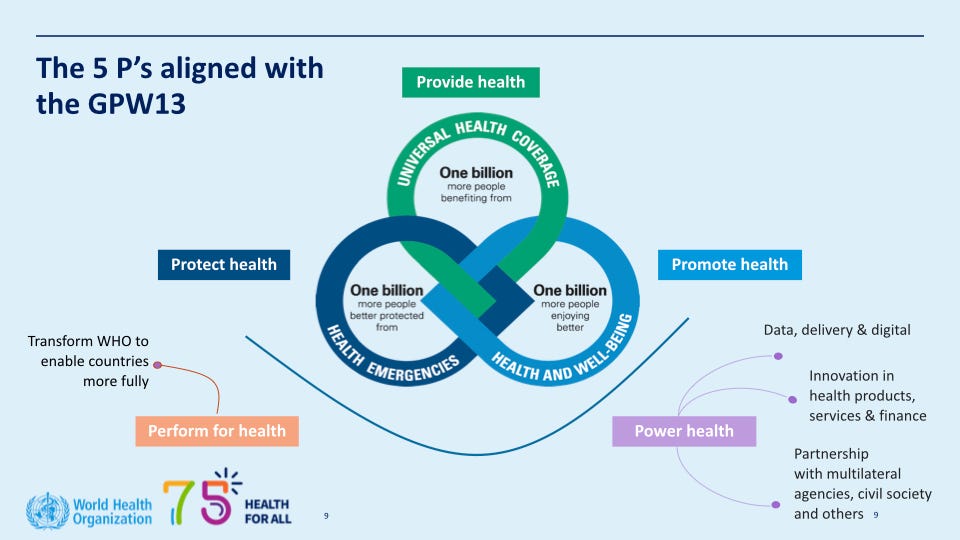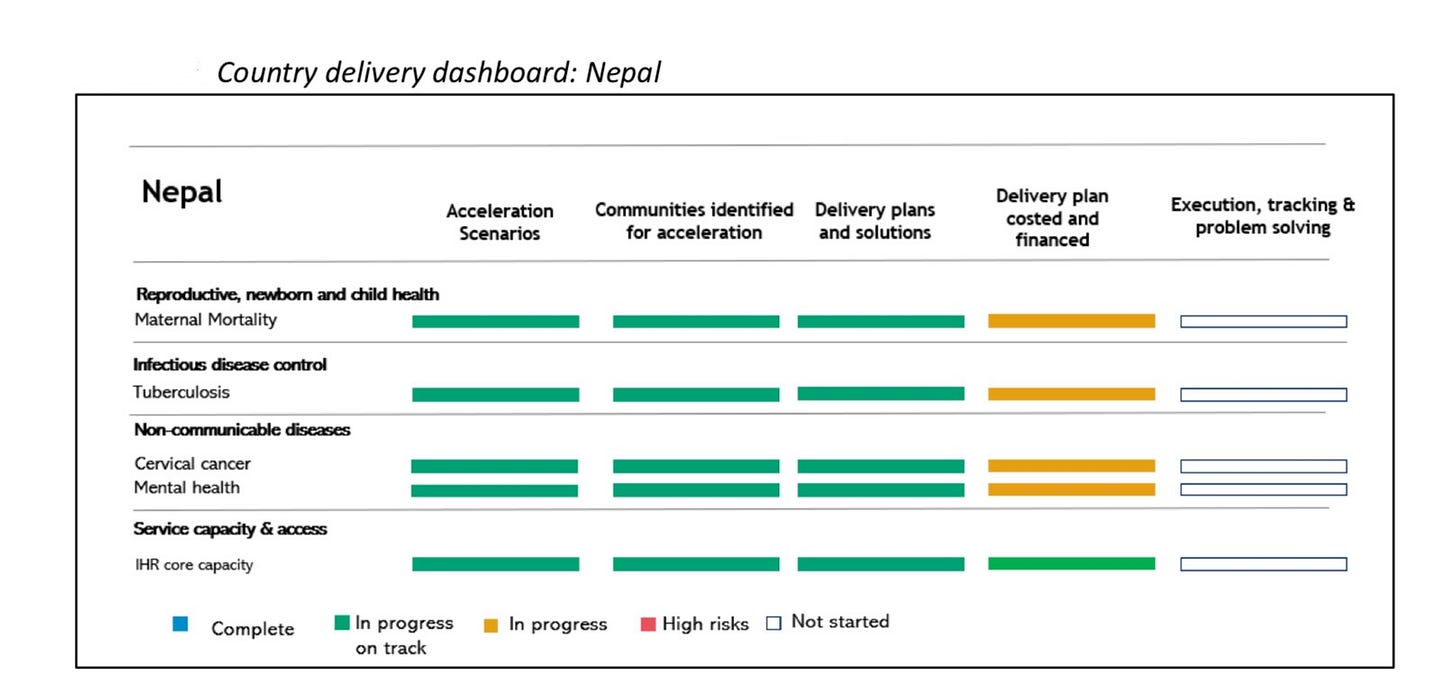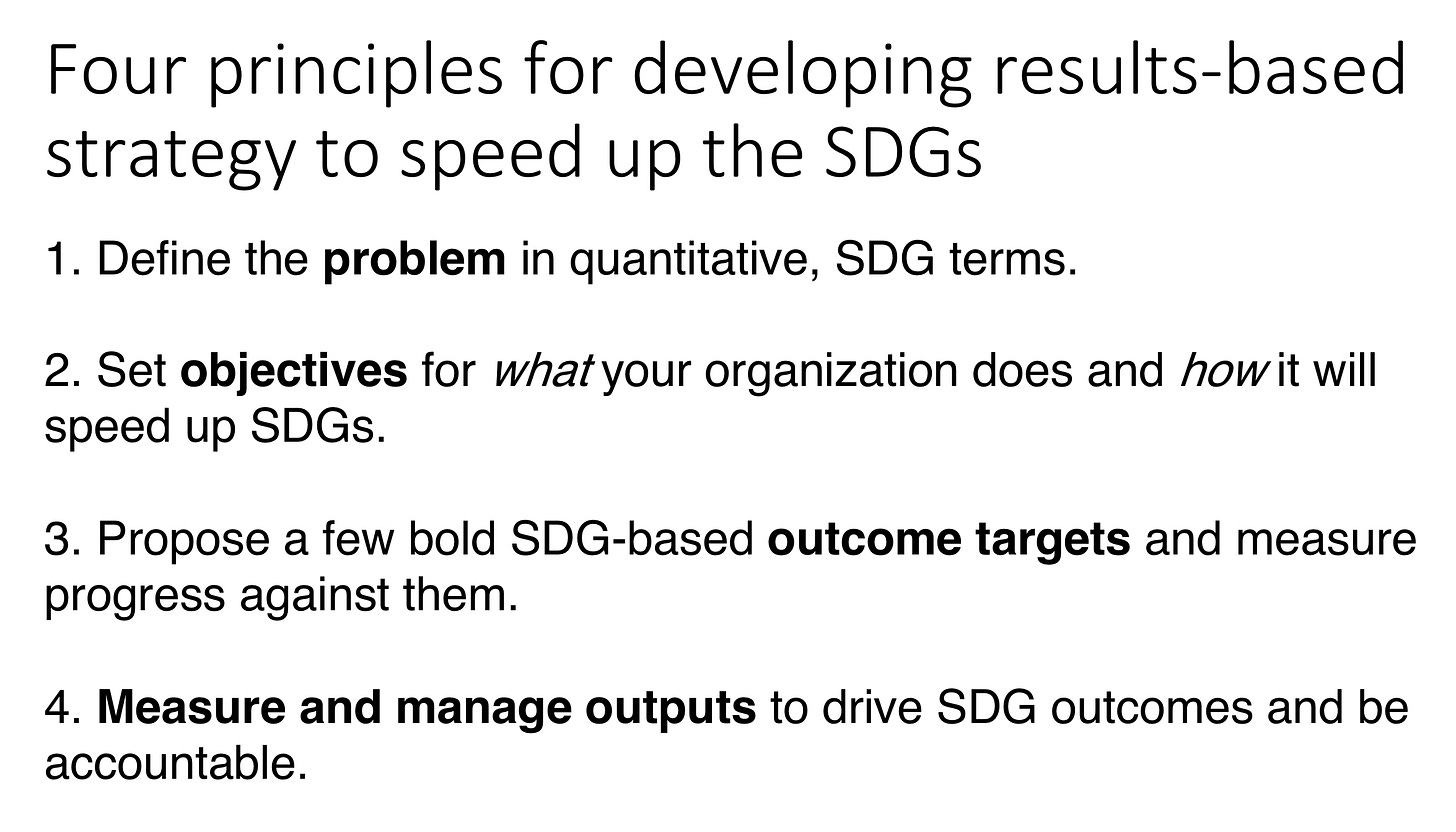WHO Directors-General are remembered for the ‘big’ things: eradication of smallpox, Framework Convention on Tobacco Control, Declaration of Alma Ata on Primary Health Care, and the International Health Regulations. But WHO’s biggest impact is what it does day-to-day and country by country.
That’s why one of my favourite photos of my brother Tedros is this one, in which he is reaching out to hold a child in an internally-displaced persons camp in Northern Nigeria (I had the privilege of accompanying him.) It epitomizes the over-arching goal of WHOs strategy: measurable impact in countries. In developing strategy, it’s good to have a guiding image like this in your mind.
WHO calls its strategic plan the “General Programme of Work (GPW).” (People are so confused by this term that even WHO insiders call it the “global” programme of work half the time.) The last strategy was known as GPW 13, originally covering the five-year period 2018-2023 and then extended, and the next one being developed now is called GPW 14, covering the four-year period 2025-2028. The draft GPW 14 is here, and the WHO Results Framework on which this blog is based is here.
According to management thinker Henry Mintzberg, “You don’t plan strategy -- you learn strategy.” I agree, which is why I wanted to lay out lessons from GPW 13, which I crystallize in four principles. While I use WHO as the case example, the principles are generalizable to any organization in any sector focused on social impact. An overarching point: if you want to speed up SDGs, drive this through your strategy.
Measuring and managing impact using results-based strategy is an essential part of the GSD (Get Sh*t Done) approach to speeding up SDGs. To read more about this approach, please see here.
Define the problem in quantitative, SDG terms
In your strategy, be explicit about the problem you are solving. This is your ‘burning platform.’ The way you define the problem sets the stage for your solutions. SDGs make defining the problem easier by providing a set of indicators and targets — the only ones agreed by every country in the world.
Unfortunately, at their midpoint, across all goals the SDGs are badly lagging. Only 15% are on track. The figure below shows progress on (mostly) health-related SDG indicators (in the rows) across countries (in the columns) in a single WHO region. You can see a lot of red, meaning the target will not be met by 2030.

The challenge is that there are so many SDG targets — more than 50 in the case of the health related SDGs, and 169 overall. While you can measure that many concepts, you cannot build a strategy around them. So WHO collapsed the health related SDG indicators into the three over-arching constructs (the “Triple Billion) and set a target of a billion more people over five years living healthier lives, having Universal Health Coverage, and being better prepared for health emergencies.
Universal Health Coverage, as we shall see below, is going at about half the pace needed to reach the 2030 targets. Doubling the pace of progress is a big stretch and requires us to focus squarely on the question: how do we speed up the SDGs?
Set objectives for what your Organization does and how it will speed up SDGs
The trick in strategy is to focus as much on the “how” as the “what.” WHO’s strategy is built around five ‘Ps’: Promote, Provide, Protect, Power and Perform. The first three represent the ‘what’ (and correspond to the triple billion targets), the fourth and fifth represent the ‘how’, as shown below.

Promote, Provide, Protect: WHO is a content-rich organization; it naturally focuses on the ‘what.’ But no amount of new content will yield the multiples needed to reach the SDGs. If content alone were enough to speed up SDG progress, we wouldn’t see such lagging progress at the mid-point of the SDG period. Also, clustering SDGs into Triple Billion targets does not preclude focussing in depth on specific priorities such as climate change (an existential threat), Primary health care / health workforce (a force multiplier across the Billions), or pandemic preparedness (to encode the lessons learned from the worst public health crisis in 100 years).
Power: It’s not the ‘what’ but the ‘how’ that is most likely to speed up the SDGs. I have devoted a four-part series in this blog to exploring these approaches in detail, and summarized them recently. The approaches to power health are: data, digital, and delivery for impact; innovation in health products, services, and finance; and partnerships among multilaterals, civil society, and the private sector. Country examples of delivery for impact in Nepal, scaling medical oxygen innovation in Somalia, and improving multilateral partnerships in Pakistan and Malawi give a glimpse of what could be achieved in the coming years to speed up SDGs.
Perform: Any Organization must be fit for purpose to deliver both the ‘what’ and the ‘how.’ GPW 13 introduced ‘organizational shifts’, which later turned into the WHO Transformation, which was then supported by an Action Results Group, rightly led by those most responsible for implementing WHO strategies, the WHO Representatives to countries.
Ultimately impact is at the country level: the issue we had in GPW 13 was how do you set a few bold measurable targets across the organization while addressing the diverse priorities of each of WHO’s 194 country members?
Propose a few bold SDG-based outcome targets and measure progress against them
Measurable targets bring accountability to an organization. They help management to focus efforts and resources. They enable governance to hold management accountable for progress. Measurable targets simplify the narrative of the organization and bold ones inspire people (but not as much as actual results).
A small, more focused organization might pick one of the 50 plus health related SDG targets (or 169 targets across the SDGs). A larger organization with a broader mandate might cluster SDG targets, as in the example of the Triple Billion.
WHO historically put measurable targets in its strategy once before: in its 3 x 5 goal, which aimed to place 3 million people on anti-retroviral therapy by 2005.
The breakthrough in WHO’s 13th General Programme of Work was that for the first time WHO set measurable targets across its entire strategy — the triple billion targets. The triple billion provided three priorities which were all measured on the same scale (number of people) making them very simple and intuitive to communicate.
At the same time, WHO serves all countries based on their own priorities. Countries can prioritize specific SDG targets and measure progress against them.
Not only did GPW 13 set measurable targets, but it also measured them, as reported on the World Health Data Hub:
We know that going forward the Triple Billion targets should be recalibrated based on the underlying SDGs. There is more on this here.
Progress on the triple billion targets serves as the starting point for the WHO Results Report, which is how the Secretariat reports to and is held accountable by Member States on its contribution to the SDGs.
The SDGs are primarily the responsibility of countries. So the key question is: how does your organization help countries to drive the SDGs?
Measure and manage outputs to drive SDG outcomes and be accountable
How do you measure and manage the outputs of your organization in contributing towards the SDGs? In the case of WHO, We didn’t solve this challenge in 2018 in the original GPW 13 strategic plan, but we developed a solution — through learning and experimentation — by 2022 in the plan to extend GPW 13.
Delivery for impact links the outputs of the organization to SDG outcomes. It is currently being used by WHO in 40 countries. An illustrative country-level delivery dashboard, with priorities selected by the country, is shown in the figure below.

You can use delivery milestones to produce a global dashboard. This could be very useful for governance programmatic accountability and management resource allocation decisions. The chart below shows selected examples under each billion.

Just as the triple billion was the breakthrough in GPW 13, measuring and managing the Secretariat’s contribution using delivery for impact could be the breakthrough of GPW 14. It could also speed up SDGs by better aligning the global health ecosystem. The SDG 3 Global Action Plan, a partnership of 13 multilateral agencies, has recommended that delivery for impact be used as a common language across the agencies to jointly support country-led implementation.
GSD
What is most needed to achieve the SDGs is GSD: Get Sh*t Done! People are not inspired by plans — but by results. The essence of the GSD approach is to measure and manage impact.
Using the four principles I outline here and an inclusive process, any organization in any sector interested in social impact can develop an SDG-based, results-based strategy to measure and manage impact. In the case of the UN and its agencies, this is results-based multilateralism.
Given the lagging SDGs, the key question for strategy development: Is there a credible pathway for doubling the pace of progress? But developing strategy is only 10% of the battle. The other 90% is implementing strategy, and that’s the hard part. Closing the gap between strategy development and implementation requires that the strategy is emphasized in the leader’s speeches, shapes budget allocations, frames results reporting, and is embedded in governance accountability.
Imagine a world where every organization focused on social impact — at least every multilateral agency — measures and manages its contribution and impact towards the SDGs. That world stands a chance of achieving the SDGs.







It's delightful to focus on outcomes rather than diluting insights in conferences and meetings.
Much appreciated !
In the realm of policy-making, economics, and health data management, there's a transformative trio: execution, tracking, and problem-solving.
This dynamic trio serves as the backbone for shifting from the intricacies of operational strategies to the partnership towards a quality-assured national health reporting.
Picture a synergy where the National System of Accounts (NSA) harmonizes seamlessly with the WHO Health Expenditures' dashboards (GHED), within a classification process technique
CHALLENGES
For NSA, to unlock economic fluctuations, data quality, and concept changes
GHED, to tackle data consistency, data integrity, and privacy concerns.
BENEFICIARIES
NSA showers benefits upon economists, policymakers, businesses, and researchers.
GHED, on the other hand, will be the key enabler to government agencies, auditors, and champions of public accountability.
IMPACT
NSA contributes to economic analysis, policy formulation, and benchmarking.
GHED takes center stage with transparency, fraud prevention, and the most sought cost optimization
Thank you peter, The essence of advancing the SDGs as you state is ACTION and IMPACT. I wonder if the work has to happen at the regional, national, global level with each small, medium and large organization taking on one target and moving forward. To my amazement even now half way through I often find that my audiences in large meetings know very little or nothing about the SDGs so with out KNOWING there will be NO action. Thank you for shedding the light on the need tor action